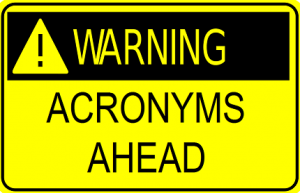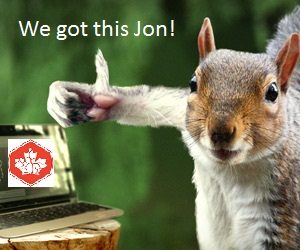All the Geomatics Acronyms You Wanted to Know but were Too Afraid to Ask

Here in Canada, there are many geomatics acronyms that get tossed around. During the recent “Team Canada” event that the CGCRT put on, more than one participant was scratching their heads, asking questions like…what is a CCOG? For a newcomer to the sector (and even a seasoned professional at times!), all these letters can get pretty confusing.
That’s why GoGeomatics Canada is breaking down the most common geomatics-related acronyms, with links to websites where applicable. This guide includes organizations and associations, companies, and general lingo.
Did we miss something? Feel free to let us know in a comment!
AAA – Accurate, Authoritative and Accessible.
ABCLS – Association of British Columbia Land Surveyors. A self-governing body charged with the responsibility of setting education requirements, examining for admission, and regulating professional land surveyors to perform legal surveys within British Columbia.
ACLS – Association of Canadian Lands Surveyors. National licensing body for professionals surveying in the three Canadian territories, in the federal parks, on Aboriginal reserves, on and under the surface of Canada’s oceans.
ACMLA – Association of Canadian Map Libraries and Archives. Representative professional group for Canadian map librarians, cartographic archivists and others interested in geographic information in all formats.
AGG – Alberta Geomatics Group. A facilitator to promote geomatics innovations amongst the sectors and augment business development opportunities.
AGRG – Applied Geomatics Research Group. A team of Research Scientists, Research Associates, and graduate students, applying a suite of Geomatics technologies to explore environmental, health and social issues. Part of Nova Scotia Community College’s Centre of Geographic Studies.
ALSA – Alberta Land Surveyors Association. A self-governing professional association that regulates the practice of land surveying for the protection of the public and administration of the profession.
AMLS – Association of Manitoba Land Surveyors. A professional self-governing body which regulates the practice of land surveying for the protection of the public and administration of the profession.
ANBLS – Association of New Brunswick Land Surveyors. Regulates and governs the profession of land surveying in New Brunswick.
ANSLS – Association of Nova Scotia Land Surveyors.
AOLS – Association of Ontario Land Surveyors. A self-governing association responsible for the licensing and governance of professional land surveyors, in accordance with the Surveyors Act.
APEILS – Association of Prince Edward Island Land Surveyors. A professional, self-governing body operating under the Land Surveyors Act (PEI).
CAG – Canadian Association of Geographers. A Canadian national organization representing practicing geographers.
CASI – Canadian Aeronautics and Space Institute. Non-profit scientific and technical organization for people interested in aeronautics, space and remote sensing.
CBEPS – Canadian Board of Examiners for Professional Surveyors. Establishes, assesses and certifies the academic qualifications of individuals who apply to become surveyors and/or geomatics professionals in Canada, except for Ontario and Quebec.
CCA – Canadian Cartographic Association. Founded with the aims of: Promoting interest in maps and related cartographic materials; furthering the understanding and knowledge of maps by encouraging research in the field of cartography; providing for the exchange of ideas and information and for the discussion of mutual concerns, through meetings and by publications; and advancing education in cartography and in the use of maps.
CCMEO – Canada Centre for Mapping and Earth Observation. The new branch created in July 2013 by the merger of Natural Resources Canada’s Mapping Information Branch (MIB) and Canada Centre for Remote Sensing (CCRS). CCMEO’s responsibilities include Earth observation and geomatics research and development, data acquisition, dissemination and archives; management of geospatial and earth materials collections; provision of services (e.g. web, geoanalytics); geomatics and Earth observation strategy; and domestic and international partnerships, among others.
CCOG – The Canadian Council on Geomatics. The major federal-provincial-territorial consultative body for geographic information management.
CCRS – Canada Centre for Remote Sensing. A branch of Natural Resources Canada’s Earth Science Sector, which provides remotely senses geographical information to decision makers, related industries and the general public.
CGCRT – Canadian Geomatics Community Round Table. A collaboration among governments (federal, provincial, territorial, municipal, and First Nations), industry educators and students, and not-for-profit organizations.
CGDI – Canadian Geospatial Data Infrastructure. An Internet/Web infrastructure comprised of the developments of the federal, provincial, territorial and private sector partners who are creating the technology, standards, access systems and protocols necessary to harmonize all of Canada’s spatial databases and to make them available on the Internet.
CIG – Canadian Institute of Geomatics. Not-for-profit association that represents some of the interests of the geomatics community.
COGS – Centre of Geographic Sciences.
CRSS – Canadian Remote Sensing Society. A constituent Society of the Canadian Aeronautics and Space Institute, providing a focus and means for disseminating technical remote sensing information through national symposia.
CSA – Canadian Space Agency.
DMTI – Desktop Mapping Technologies Inc.
ESRI Canada – Environmental Systems Research Institute Canada. A privately held, Canadian-owned company that provides world-class enterprise geographic information system (GIS) solutions.
FCGEO – Federal Committee on Geomatics and Earth Observation. A committee focused on providing proactive, whole-of-government leadership in establishing priorities for geomatics and Earth observation in support of government priorities, decision-making, and Canada’s competitive advantage; and, collectively enhancing the responsiveness, efficiency and sustainability of the federal geomatics and Earth observation infrastructure.
FGDC – Federal Geospatial Data Committee. An interagency committee that promotes the coordinated development, use, sharing, and dissemination of geospatial data on a national basis.
FGP – Federal Geospatial Platform. An initiative of the (FCGEO). A committee of senior executives from 21 departments and agencies that are producers and/or consumers of geospatial data, or have an interest in activities, requirements and infrastructure related to geomatics.
FIG – International Federation of Surveyors. the UN-recognized global organization for the profession of surveying and related disciplines.
FOSS4G – Free and Open Source Software for Geospatial.
GANS – Geomatics Association of Nova Scotia. A non-profit association to help further promote the development of the Geomatics Industry in Nova Scotia, while making it competitive both domestically and internationally, and increasing its material contribution to the provinces economy.
GEO – Group on Earth Observations. Coordinates international efforts to build a GEOSS. It links existing and planned Earth observation systems and supports the development of new ones to construct a global public infrastructure for Earth observations that consists of a flexible and distributed network of content providers.
GEOSS – Global Earth Observation System of Systems. Seeks to connect the producers of environmental data and decision-support tools with the end users of these products, with the aim of enhancing the relevance of Earth observations to global issues.
GeoWeb – Geospatial Web. A term that implies the merging of geographical (location-based) information with abstract information on the Internet, creating an environment where one could search by location instead of keyword only.
GIAC – Geomatics Industry Association of Canada. A national business organization which conducts promotional, educational and advocacy activities to assist its members to develop new business in Canada and around the world and undertakes a range of initiatives to improve the international competitiveness of the industry. (This group is currently in Limbo)
GIS – Geographic Information System
GML – Geographic Markup Language
GNBC – Geographical Names Board of Canada. The national committee that authorizes names on official, federal government maps.
GPS – Global Positioning System
GSDI – Global Spatial Data Infrastructure. A set of policies, standards, practices, technologies and relationships to facilitate the flow of geographic data and information at all levels across government, academic, and private sectors globally. It is the top level of a hierarchical structure, linking multiple levels of jurisdictions’ (municipal, provincial/state, federal, regional) spatial data infrastructures.
GSC – Geological Survey of Canada. A branch of the Earth Sciences Sector of Natural Resources Canada, responsible for performing geological surveys of the country, developing Canada’s natural resources and protecting the environment.
IACG – Inter-Agency Committee on Geomatics. Together with the Canadian Group on Earth Observation (CGEO), was replaced in 2012 with the creation of the Federal Committee on Geomatics and Earth Observation (FCGEO), which brought these two federal coordination committees together.
ISO – International Organization for Standardization. A worldwide federation of national standards bodies from more than 160 countries. The ISO’s mission is to promote the development of standardization and related activities in the world to facilitate the international exchange of goods and services, and to develop cooperation in the spheres of intellectual, scientific, technological and economic activity. The ISO’s work results in international agreements that are published as international standards.
LBS – Location-Based Services
LIO – Land Information Ontario. A provincial initiative that supports the province-
LL – Life-long Learning
MGUG – Manitoba GIS Users Group. A group of GIS professionals using geographic information systems for spatial data management, analysis, and visualization.
NIF – National Information Framework
NRCan – Natural Resources Canada. The ministry of the government of Canada responsible for natural resources, energy, minerals and metals, forests, earth sciences, mapping, and remote sensing.
NSDI – National Spatial Data Infrastructure (US).
OAGQ : Ordre des arpenteurs-géomètres du Québec
OARS – Ontario Association for Remote Sensing. Educates, communicates, and facilitates on a wide variety of remote sensing and geomatics topics. The membership is composed of small business, industrial, and educational members providing for an insightful exchange of ideas.
OGC – Open Geospatial Consortium. An international industry consortium of 481 companies, government agencies and universities participating in a consensus process to develop publicly available interface standards.
OGS – Ontario Geological Survey. Conducts mapping and geoscientific research throughout the year.
OSGeo – Open Source Geospatial Foundation. A non-profit non-governmental organization whose mission is to support and promote the collaborative development of open geospatial technologies and data.
PLS – Provincial Land Surveyor
PSI – Public sector information
R&D – Research and Development
RADARSAT – RADAR Satellite
RCGS – Royal Canadian Geographical Society. A non-profit education organization dedicated to imparting a broader knowledge and deeper appreciation of Canada, its people and places, its natural and cultural heritage and its environmental, social and economic challenges.
SDI – Spatial Data Infrastructure
SDTS – Spatial Data Transfer Standard
SLSA – Saskatchewan Land Surveyors Association. An organization of land surveyors and professional surveyors who are registered to practice in accordance with the provisions of The Land Surveyors and Professional Surveyors Act of the revised statutes of Saskatchewan.
UNCE-GGIM – United Nations Committee of Experts on Global Geospatial Information Management
W3C – World Wide Web Consortium. An international community that develops open standards to ensure the long-term growth of the Web.
WCS – Web Coverage Services
WFS – Web Feature Services
WMC – Web Map Context
WMS – Web Map Service
WMTS – Web Map Tile Service
VGI – Volunteered Geographic Information







Thanks for the list! Here are two other acronyms:
OAGQ : Ordre des arpenteurs-géomètres du Québec
GPS: Global Positioning System
LIO = Land Information Ontario
CGS – Certified Geomatics Specialist (by CIG)